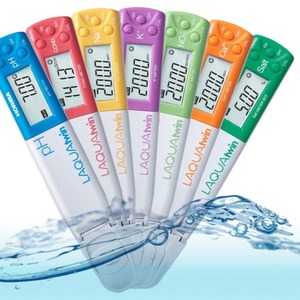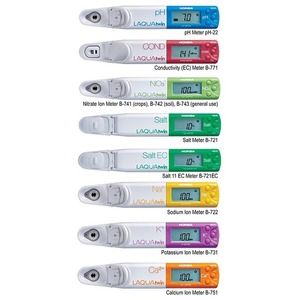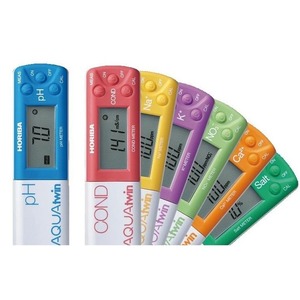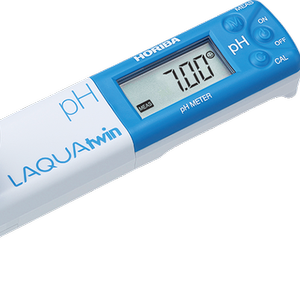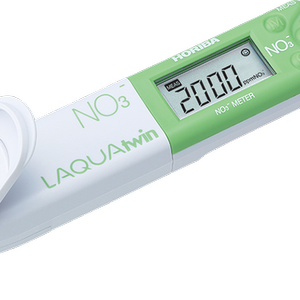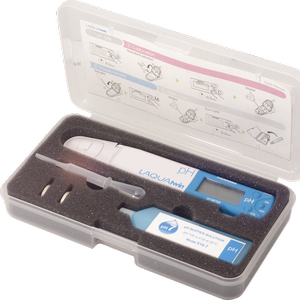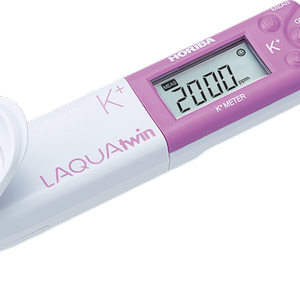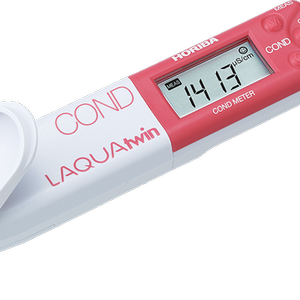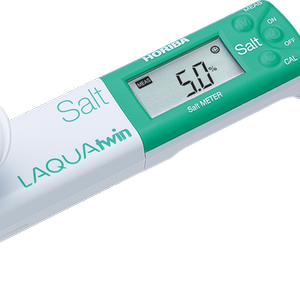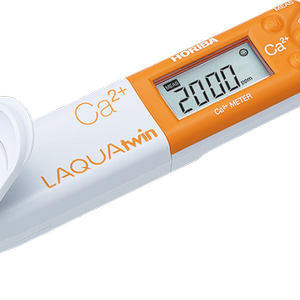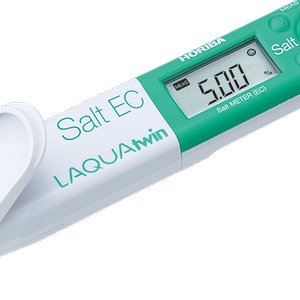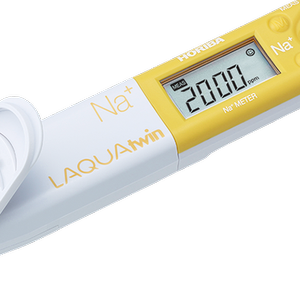pH and Temperature
-
Food & Dairy
-
Data Acquisition & Logging
-
UV Measurement
-
Air Safety
-
Modified Atmosphere Packaging / Gas Flushing
-
Near-Infrared (NIR)
-
Test Kits
-
Milk Analysis
-
pH and Temperature
-
Refractometry & Density
-
Microscopy
-
Stirring & Mixing
-
Water activity / Moisture
-
Viscosity & Rheology
-
Weighing Solutions
-
Colour Analysis
-
Permeation
-
Atago
-
-
Grain
-
Feed
-
Soil, Science & Environment
-
Discontinued Products
Compact pH Meters
8 Water Quality Parameters: pH, Conductivity, Total Dissolved Solids (TDS), Ions (Na+, K+, NO3-, Ca2+) and Salt Employing the same test principle as laboratory electrodes, LAQUAtwin compact meters provide a reliable and accurate measurement. Select your meter that best suits your application from 11 colorful models.
Accurate reading from a single drop of sample in just a few seconds. Incorporating the same parts as standard laboratory electrodes, the LAQUAtwin compact meters are built with miniaturized components and unique flat sensor chip, which is less than 1 mm thick—a result of 60 years of HORIBA’s sensor engineering technology.
Calibrate and measure at the touch of a button. Read the result when appears. Hassle-free operation with single-button calibration and measurement. Record the reading once a smiley face appears on the display.
Fully waterproof and dustproof (IP67 rated)1 with backlight display
The LAQUAtwin compact meters can be used anywhere and anytime. No need to worry with water splashes or inclement weather during measurement. With the meter’s backlight display, you may view the reading in testing sites with poor light condition.
1Withstand immersion for 30 minutes at 1m depth. Not suitable for underwater use.
Quick - No container is needed to calibrate or measure. Only few drops of standards and samples are all you need.
Variety - Measurements can be made in different positions because of the sensor design.
Anyone -Easy & simple operation makes everyone an expert.
Solution - Discover more with easy, on-site measurement.
Wherever -IP67 rated dust/waterproof. Carry LAQUAtwin and its accessories in a carrying case.
Reliable -HORIBA 60 years sensor technology distilled in HORIBA’s unique flat sensor.
Cost effective - 1/100 of standard solution and sample volume is needed. Sensor is replaceable.
B-713 - pH Meter
B-771 - Conductivity Meter
B-741(crops) - Nitrate Ion Meter, B-742(soil), B-743( general use)
B-721 - Salt Meter
B-721EC - Salt 11 EC Meter
B-722 - Sodium Ion Meter
B-731 - Potassium Ion Meter
B-751 - Calcium Ion Meter
pH and Conductivity Measurements in Coconut Coir Substrate Coconut coir testing involves extracting a sample solution with distilled water and measuring the pH and conductivity of the extract. The acceptable conductivity ranges for 1:2 (v/v) dilution and pour thru sampling methods are 0.26-0.75 mS/cm and 1.0-2.6 mS/ cm, respectively. The ideal pH range is 5.4-6.2 for both methods.
Determination of Nutrient Concentrations in Soil Solution and Tomato Plant Sap Fertigation management requires rapid and accurate methods to determine nutrient concentrations in soil solution and plant sap. Folegatti et al (2005) found that the concentrations of NO3-, K+, and Na+ in soil solution and tomato plant sap determined by LAQUAtwin ion pocket meters showed good correlations with those obtained in soil solution and in leaf dry matter, respectively, determined by standard methods in laboratory, and concluded that LAQUAtwin ion pocket meters are useful low-cost tools in fertigation management.
Measurement of pH in Plant Tissue An optimal pH value of 6.4 in plant tissue will encourage healthy growth and prevent insects and diseases attacking the plant. To measure pH, squeeze the sap of mature leaves with garlic press and place the sap onto the sensor of LAQUAtwin pH meter.
Conductivity and Elephant’s Foot Testing Elephant’s foot is a physiological disorder in sweet pepper (Capsicum annuum L.), where the base of the plant’s stem becomes swollen below the cotyledon level and wounds develop at the base of the stem’s epidermis because of salt accumulation. LAQUAtwin conductivity meter can be used to measure conductivity of soil and help farmers choose the best land to grow sweet pepper crops.
Soil pH and Nutrient Availability The desirable soil pH range for optimum plant growth varies among crops. Generally, soil pH6.0-7.5 is acceptable for most plants as most nutrients become available in this pH range. Soil pH can be determined by mixing soil sample with water and then measuring the resulting aqueous solution.
Soil Nitrate Measurement for Determination of Plant-Available Nitrogen Nitrate concentration in soil is a good indicator of available nitrogen to plants. The required soil nitrate nitrogen (NO3-N) for specific crops varies from crop to crop but in general, a concentration range of 10-50 mg/kg is desired.
Soil Salinity Measurement in Almond Orchard Crops have different levels of tolerance to salinity. Testing soil salinity is the best way to check soil condition in the orchard before salt damage occurs. The EC1:5 test is used to estimate soil salinity (ECe). The soil salinity threshold value for almond is 1.5 mS/ cm.
Impact of Soil Salinity on Sugar Cane Yield Soil salinity adversely affects the growth of sugar cane crops. To help optimize sugar cane yield, check the sodium content in soil by mixing it with water in 1:5 ratio and measuring the resulting solution with LAQUAtwin sodium ion meter.
Measurement of Calcium in Soil Calcium is one of the essential nutrients taken up by plants from soil for cell wall development. To measure calcium concentration in soil, extraction with 1M ammonium acetate and filtration should be performed prior to placing the filtrate onto the flat sensor of LAQUAtwin calcium ion meter.
Measurement of Potassium in Soil In laboratories, potassium in soil is extracted with 1M ammonium acetate and analyzed with Atomic Absorption (AA) or Inductivity Coupled Plasma-Optical Emission Spectrometry (ICP-OES). LAQUAtwin potassium ion meter showed values higher than those of ICP-OES. However, with 0.01M ammonium acetate extraction, good correlation (r=0.981, r2=0.962) was obtained between ICP-OES and LAQUAtwin potassium ion meter.
Potassium Determination in Plant Tissue Comparison of LAQUAtwin Potassium Ion Meter and ICP Spectrometry Trials revealed close significant correlation (r values were 0.80 and 0.93 for first and second trials, respectively) between the LAQUAtwin potassium ion meter readings and ICP results obtained from plant’s fresh petiole sap and dried tissue, respectively. This suggested that LAQUAtwin potassium ion meter could be an appealing field method substitute for rapid determination of potassium concentration in plants.
Measurement of Potassium in Rice Potassium is one of the essential plant nutrients supplied via fertilizer in most irrigated rice fields. Extracting sap from the lower stem of plant rice and analysing it with LAQUAtwin potassium meter provide indication of the current potassium status and help farmers adjust the fertilizer application.
Rapid In-Field Determination of Nitrogen in Onions Fresh root sap analysis with LAQUAtwin nitrate ion meter offers cost-effective, rapid, and easy solution to determine nitrogen status in onion plants. The nitrate nitrogen (NO3-N) concentrations in onion vary at different growth stages. The acceptable root sap NO3-N concentration range for 0.5 to 1.5- inch onion bulbs is 350 to 500 ppm.
Nitrate Measurement in Turf Grass Nitrate concentration in grasses can be used as an indicator of soil nitrogen (N) availability for their growth. Research at the University of Connecticut suggests verdure sap nitrate-N concentrations at 200-300 ppm as the optimum level.
Quick Nutrient Analysis in Strawberry Production Regular monitoring of nutrient levels such as nitrate (NO3-), potassium (K+) and calcium (Ca2+) in plant petioles, soil solution, irrigation water, and drain water produces not only good yield and fruit quality, but also reduces fertilizer cost and mitigates environmental hazards. The LAQUAtwin pocket meters are the perfect tools for testing as they directly measure samples and provide results in just few seconds allowing growers to identify and correct any nutrient deficiency or excess immediately.
pH and Conductivity for Testing Acrylic Paint Films and Paper Supports and Formulating Aqueous Cleaning Solutions Isotonic aqueous cleaning solutions that match the pH and conductivity readings of acrylic paint films and paper supports obtained from agarose gel pellets have been shown to be effective in reducing or removing dirt, dust, active mold growth and associated stains, tide line stains, and discoloration.
Aquarium Water Testing Testing aquarium water such as freshwater and saltwater (either natural or artificial seawater) with reliable instruments is necessary to create a clean and safe environment for your aquatic species. The LAQUAtwin pocket meters require only few drops of water and deliver the results in just few seconds.
pH Measurement in the Acidification of Fermented Sausages Lowering pH or increasing acidity of meat has become main hurdle against pathogenic bacteria in sausage making. pH is used in the course of fermentation process in order to produce microbiologically stable product that has a pH value of 5.3 or less.
pH of Brine for Canned Food Testing For brine of canned acid foods, the equilibrium pH value must be 4.6 or below to inhibit the growth of Clostridium botulinum, the most heat resistant of the food pathogen microorganisms.
pH Measurement to Determine Freshness of Meat Products Fresh meat must have a pH value in the range of 5.5 to 6.2 before selling to consumers. LAQUAtwin pH meter provides a simple and cost effective way to check the freshness of meat in the local markets.
pH Measurement to Determine Acidification of Sushi Rice The rice used for sushi must be acidified with acetic acid (vinegar) to pH less than 4.6 to inhibit the growth of pathogenic bacteria. To measure pH, simply place a sample of rice mixture onto the flat sensor of LAQUAtwin pH meter.
pH Measurement of Pickled Fruits and Vegetables Pickling is a process of preserving fruits and vegetables in brine, oil, water or vinegar. The Australia New Zealand Food Standard Code 2.3.1 requires the preserved fruits and vegetables to have a pH not greater than 4.6 to prevent botulism.
Determination of Sodium Content in Food Samples Foods contain varying amounts of salt (NaCl), which has 40% sodium. Determining the sodium content in foods accurately reduces the health risks associated with it. The American Heart Association recommends consumption of less than 1500 mg/day sodium for most American adults, which is the level with the greatest effect on blood pressure.
Sodium Value Check for Canned Food There is a growing concern on canned foods with large sodium content as excessive intake of sodium can cause high blood pressure and hypertension. To check the sodium content in canned food, dilute a sample with DI water in 1:5 ratio, then place the resulting solution onto the LAQUAtwin sodium ion meter.
Measurement of Calcium in Milk and Milk Beverages Determining the calcium content of milk and milk beverages helps consumers accurately gauge their calcium intake. Unlike atomic absorption spectroscopy (AAS) and inductively coupled plasma atomic emission spectroscopy (ICP), the LAQUAtwin calcium ion meter offers a simpler method of measuring calcium ion-ionizing protein bound calcium in sample using acid before analysis.
Measurement of Sodium in Athlete’s Sweat Determining the sodium concentration in sweat and replacing that with proper electrolyte intake prevent fluid and electrolyte imbalances. Sweat can be easily extracted from sterile patches applied on skin and tested with LAQUAtwin sodium ion meter. According to Gatorade Sports Science Institute, the sodium results obtained with HORIBA falls within 15.4 mEq/L 95% of the time.
Nitrate Measurement in Hybrid Sudangrass and Pearl Millet Hays Determining the nitrate concentrations of sudangrass and pearl millet before feeding them to livestock prevents nitrate toxicity. Plant sap testing with LAQUAtwin B-743 nitrate ion meter offers fast and accurate nitrate in-field analysis. Generally, the maximum nitrate concentrations considered safe for all cattle are 820 ppm and 700 ppm for sudangrass sap and pearl millet sap, respectively.
Residual Sodium Check During Cleanin- Place Process Caustic soda or sodium hydroxide (NaOH) is the chemical commonly used in alkaline cleaning solution for clean-in-place (CIP) in process plants. Measuring the sodium ion concentration on the water rinse or swab can indicate whether residual chemical has been removed properly from the process equipment.
pH of Cement for Floor Installation Testing Fresh concrete is usually very alkaline, above pH 11. When the alkalinity in a concrete subfloor is high, it can stop the floor covering adhesive from bonding properly to the concrete. Australian Standard 1884 for resilient flooring installation states the the pH level of the concrete surface should be between 9 and 10 before the flooring can be installed.
Measuring Salinity of Water Measuring the salinity or the dissolved salt content of water is important as aquatic organisms, livestock, and crops thrive at different salinity levels. Freshwater has a salinity value of less than 0.5 ppt while seawater has an average salinity of 35 ppt.
Measurement of Calcium in Drinking Water Determining the calcium content of drinking water helps consumers accurately gauge their calcium intake. Unlike atomic absorption spectroscopy (AAS) and inductively coupled plasma atomic emission spectroscopy (ICP), the LAQUAtwin calcium ion meter offers a simpler method of measuring calcium ion - ionizing bound calcium in water using acid before analysis.
Determination of Potassium in Sea Water Seawater has high ionic strength. To eliminate matrix effect in measuring potassium (K+) concentration, standard solutions made with the same background as the seawater sample are recommended for calibration. The result of measurement using the LAQUAtwin Potassium Ion meter is within ±10% of typical seawater concentration.

